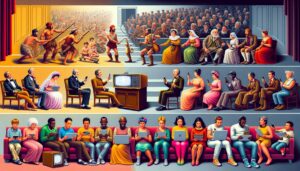The Art Behind Video Game Graphics: From Pixels to Hyper-Realism
In the kaleidoscopic world of video games, graphic design serves as the silent narrator, setting the stage for immersive experiences. From the early days of pixelated figures to today’s near-photorealistic environments, the evolution of graphic design in video games is a journey marked by technological innovation, artistic expression, and cultural influence. In this post, we delve into how video game graphics have transformed, shaping not just how we play games but how we perceive the virtual worlds they create.
The Pixel Era: The Beginnings of Video Game Graphics
The story of video game graphics begins in the era of 8-bit and 16-bit graphics. Iconic games like ‘Pac-Man’, ‘Mario’, and ‘The Legend of Zelda’ were born in this era. Despite the limitations in resolution and color palettes, designers created memorable, distinctive visuals. This era was characterized by the necessity of imagination; blocky, pixelated characters and simple backgrounds forced players to fill in the gaps, making the experience surprisingly personal and engaging. Speaking of engaging design, if you need help with Graphic Design in Casper, WY, call these guys – they can surely help you out!
The Shift to 3D: A New Dimension in Gaming
The leap into 3D graphics in the 90s marked a significant milestone. With consoles like the PlayStation and Nintendo 64, games like ‘Final Fantasy VII’ and ‘Super Mario 64’ brought new perspectives to gaming. This shift wasn’t just about aesthetics; it revolutionized game design and storytelling, allowing for more complex narratives and immersive worlds.
The Age of Realism: Pushing the Boundaries
As technology progressed, so did the capabilities to render more realistic environments and characters. The introduction of advanced rendering techniques, high-definition resolutions, and sophisticated animation led to a new era of hyper-realism in games like ‘The Last of Us’ and ‘Red Dead Redemption 2’. These games offer cinematic experiences, blurring the lines between movies and video games.
The Role of Artistic Vision: Beyond Realism
While realism has been a significant trend, artistic vision remains central. Games like ‘Journey’ and ‘Ori and the Blind Forest’ demonstrate that unique artistic styles can create worlds just as immersive and emotionally engaging as their realistic counterparts. These games are a testament to the power of graphic design in establishing mood, theme, and narrative.
The Future: Virtual Reality and Beyond
Looking ahead, virtual reality (VR) and augmented reality (AR) are setting the stage for the next revolution in video game graphics. These technologies offer a level of immersion previously unimaginable, creating fully interactive 3D environments. As we step into these virtual worlds, the role of graphic design becomes more crucial, needing not only to convince the eye but also to guide and engage all the senses.
Conclusion
The evolution of graphic design in video games is a narrative of technological advancements intertwined with creative vision. From the humble pixel to the sophisticated 3D models of today, graphic design has continuously reshaped the gaming landscape. As we look forward, one thing is certain: the fusion of art and technology will continue to push the boundaries of what is possible, creating new worlds for us to explore and experience.






